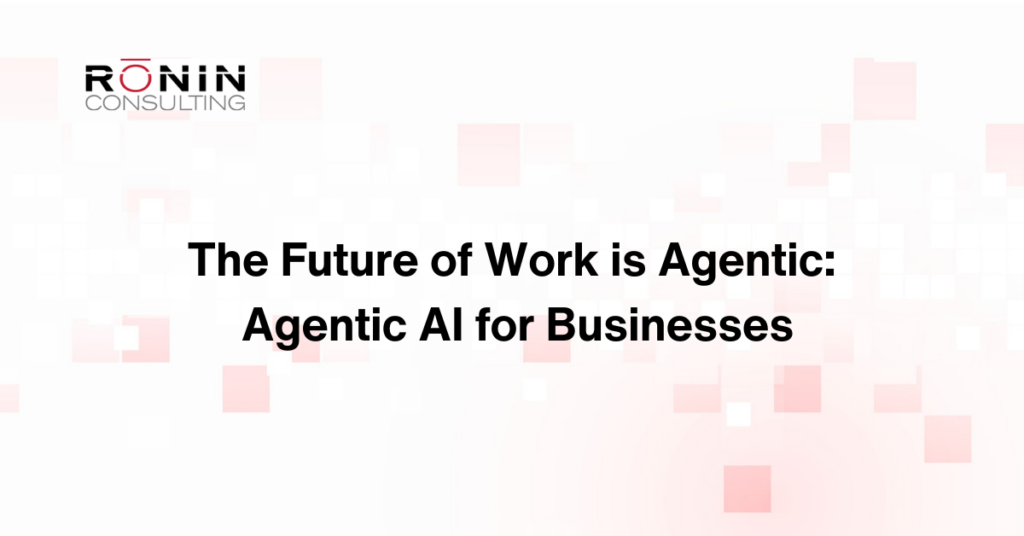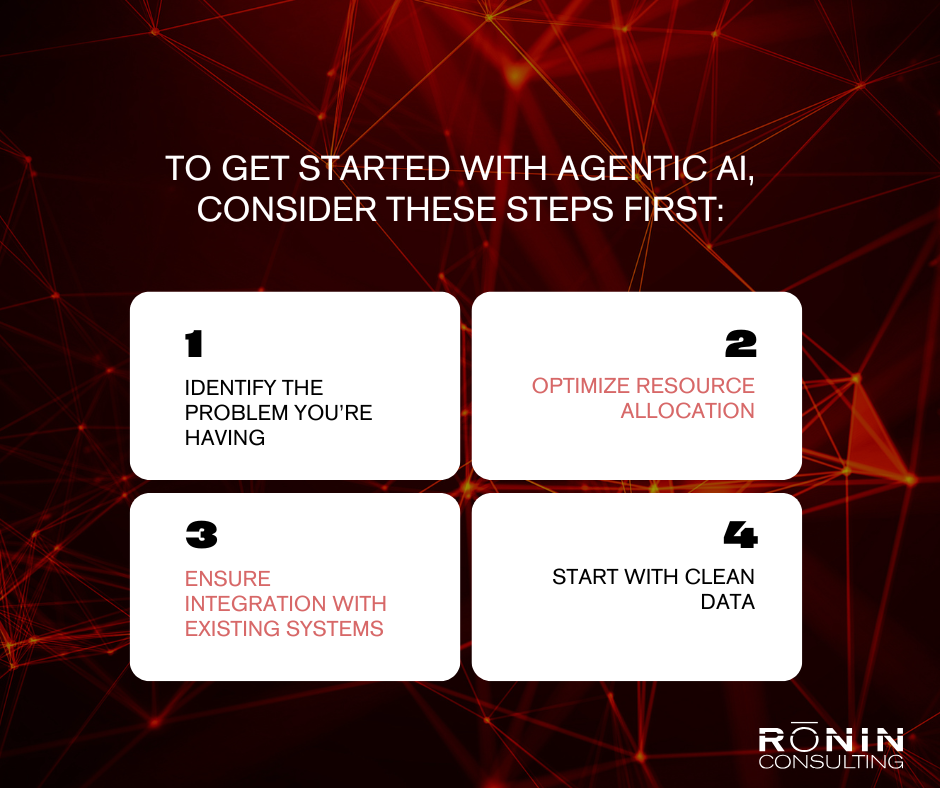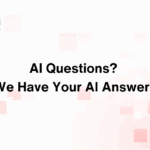
A Leader’s Guide to Agentic AI
Agentic AI, once a niche concept, now plays a central role in the evolution of artificial intelligence for business. When businesses implement it effectively, agentic AI acts autonomously. It can take initiative, make decisions, and work alongside humans or other agents to accomplish objectives. Unlike traditional systems that follow pre-defined logic, agentic AI leverages autonomy and tool use to complete tasks with minimal human intervention.
Gartner predicts a sharp rise in agentic AI adoption: by 2028, 33% of enterprise software applications will feature agentic capabilities, up from less than 1% in 2024. Over this same period, analysts expect agentic AI to make at least 15% of daily work decisions, a leap from virtually zero today.
These numbers point to the growth of technology, which will become very important for businesses in making informed, strategic decisions. This article will discuss top business considerations for implementing agentic AI and practical insights for applying this new technology to your business.
What is agentic AI?
Agentic AI refers to systems that demonstrate goal-directed behavior.
Unlike earlier AI assistants that followed rigid rules and lacked autonomy, agentic AI can take meaningful action on our behalf. But what exactly does that mean, and what is agentic AI?
Agentic AI is like a trusted partner who doesn’t wait for instruction,” says Byron McClain, Co-Founder of Ronin Consulting. “It anticipates your needs, makes smart decisions, and takes action to achieve your goals, transforming how business process tasks are completed.”
These agents don’t only react to inputs. They proactively plan, act, and collaborate with other agents or humans to complete complex tasks. Businesses using AI agents have an additional developer in their pocket or a strategic teammate on their bench—able to take the initiative, manage workflows, and deliver outcomes with minimal oversight.
Why should business leaders focus on implementing agentic AI?
Agentic AI is an emerging opportunity and a technology that innovative business leaders should not overlook. AI agents will become the primary way we interact with computers in the future,” says Microsoft’s CEO Satya Nadella. “They will be able to understand our needs and preferences and proactively help us with tasks and decision making.”
This vision is not too distant, and AI agents are already taking shape. From implementing them on websites, to sales and marketing, or customer service opportunities, AI agents are stepping into roles traditionally held by humans, handling everything from routine tasks to decision support.
For forward-thinking leaders, now is the time to explore agent-based architectures. To get started with agentic AI in your business, consider the following first:
- Identify the problem you’re having
- Optimize resource allocation
- Ensure integration with existing systems
- Start with clean data

Identify the problem you’re having.
Before adopting agentic AI, clearly define the problem it needs to solve. Don’t fall into the trap of using AI just because everyone else is. It’s not about chasing trends but about solving your unique business challenges.
Agentic AI thrives in outcome-driven environments where autonomy, adaptability, and continuous learning are essential.
So ask yourself:
- Where in your workflow could you use consistent, scalable, intelligent support?
- What tasks demand critical thinking, empathy, or decision-making under pressure?
Take healthcare as an example. Hospitals and clinics often struggle to train nurses not only in procedures but in communication, empathy, and cultural sensitivity, especially under pressure. Traditional training programs often fall short of replicating real-world complexity.
So, consider your business problem again and ask yourself: would implementing an AI agent improve the experience for clients, shareholders, employees, or patients?
If the answer is yes, you’re on the right track.
Optimize your resource allocation.
AI agents excel at handling time-consuming tasks that pull skilled professionals away from high-impact work.
Consider this: salespeople spend 71% of their time on non-selling activities, while service reps spend 66% on tasks that don’t involve the customer directly.
Now imagine what it would look like to reclaim that time. With AI agents managing scheduling, data entry, follow-ups, or internal reporting, your team can refocus on what they do best: selling, supporting, and building relationships.
Over time, these gains will compound. Teams will become more agile, customer interactions will improve, and burnout will decrease as employees spend more time on meaningful work. Agentic AI doesn’t just offload tasks; it transforms the time spent across your organization.
Ensure integration with existing systems.
One of the most critical steps in deploying agentic AI is ensuring smooth integration with your existing tech stack. Compatibility with platforms like EMRs, CRMs, ERPs, or proprietary systems determines how quickly and effectively AI agents deliver value. Without access to the right systems, agents are limited in what they can observe, learn from, and act upon.
If your tech stack is outdated, fragmented, or heavily siloed, it may need modernization before agents can operate effectively. However, updating your infrastructure doesn’t necessarily mean a complete rebuild, so don’t panic!
Modernizing your tech stack could involve introducing APIs, consolidating duplicate systems, or migrating legacy tools to the cloud—all to create a flexible, connected environment where AI can operate without friction. A key enabler of this seamless integration is the Model Context Protocol (MCP), an open standard that simplifies and standardizes how AI agents, especially large language models (LLMs), connect to external data sources and tools. MCP helps ensure these systems can reliably access the information they need, making AI integrations easier, more consistent, and more scalable across your organization.
Remember that choosing the right implementation partner is as important as selecting the right technology. Look for vendors or consultants who understand agentic architectures, have experience with system integration, and can offer tailored strategies for your industry.
Successful agents start with clean data.
Agentic AI is only as good as the data behind it.
For agents to make smart decisions, take initiative, and work independently, they need access to reliable, well-organized information. If your data is messy or incomplete, your results will be, too.
AI agents depend on data the way people depend on experience. If that experience is based on outdated info, missing details, or bad assumptions, the choices that follow won’t be trustworthy. And once trust is gone, it’s hard to rebuild.
Here’s the problem: most enterprise data isn’t neatly packaged. Around 80% of it is unstructured—emails, PDFs, voice recordings, images, even scribbled notes. In the past, this kind of data was hard to use. But with the rise of LLMs, we can now pull useful insights from these sources with much more accuracy.
Howeve, to truly benefit from agentic AI, organizations need more than clean spreadsheets and tidy databases. They need systems that can handle the messy stuff, too. That means investing in modern AI tools that go beyond basic data pipelines. Tools that can process text, images, and audio together. Tools that actually understand context.
With the right setup, AI agents can move from routine automation to real problem-solving and collaboration. Your data—structured or not—isn’t just powering the system. It’s the foundation it’s built on.
Consider a strategic approach to agentic AI
Agentic AI represents more than just an upgrade to your tech stack; it’s a reimagining of how work gets done in your business. However, success will not come from deploying a new tool in isolation. It comes from aligning this technology with the right problems, supported by clean data, integrated systems, and clear business outcomes.
The companies seeing the most success aren’t trying to do everything at once; they’re picking smart use cases, testing ideas, and learning as they go. If you approach this new technology with a clear problem and a solid foundation, agentic AI will become a powerful part of your team’s work, not just a flashy add-on.
Want to explore what that could look like for your business?
Contact our team, and we’ll help you identify where agentic AI makes sense, build momentum, and stay focused on what matters.





